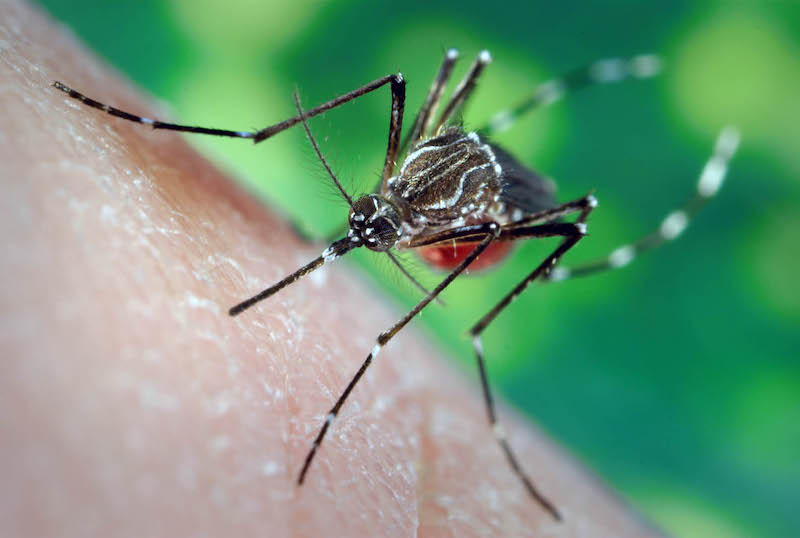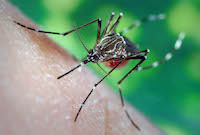Mosquito activity this spring has been nearly as erratic as Georgia’s recent weather.
Following an unusually wet 2018, periods of heavy rain this spring produced standing water in many low-lying areas. In May, it quickly turned hot and dry, plunging most of the state into an abnormally dry to moderate drought status, according to the U.S. Drought Monitor map.
While the lack of rain across Georgia dried up some mosquito larval habitats, the recent spell of hot afternoons and warm nights has spurred larval development where water has remained, initiating mosquito season in earnest.
Mosquito larvae have been observed in essentially everything that holds water in the past few weeks and the warm nights have only served to increase their rate of development.
In the wake of the significant rains over the past few days, homeowners should eliminate any standing water left behind. Mosquitoes require standing water for their larval and pupal stages, so the elimination of all forms of standing water is extremely important around homes and in communities.
The female mosquito will lay eggs on the surface of standing water or in places that later become flooded or filled with water. Once the eggs have been wet for a period of time, they hatch, and the larvae feed on particles and graze on algae-covered surfaces in their larval habitat. The larval stage may only require five to six days on the warmest Georgia nights, but larvae usually take a little longer before transforming into the pupal stage.
After two to three days as a pupa, adult mosquitoes emerge onto the water’s surface and begin their search for nectar and plant juices that are used for flight energy. The female will look for a blood meal to acquire the nutrients needed to stimulate egg production. It is this need to blood feed that makes mosquitoes such a serious nuisance and public health pest.
Last year Georgia had 34 cases of West Nile virus detected and two deaths. One case of eastern equine encephalitis and one case of St. Louis encephalitis were also detected. While these numbers aren’t overwhelming, the mosquito control profession considers all mosquito-borne disease to be preventable.
Any time encephalitis (inflammation of the lining of the brain) is involved, it can become very serious and have long-lasting effects. For West Nile virus, many people are exposed to the virus and do not show any symptoms. It’s estimated that 20% of the people exposed to the West Nile virus develop West Nile fever, and 1 in 150 people develop a more severe form of the disease. These cases involve high fever, severe headaches and disorientation that can have long-lasting effects.
This is why it is so important to prevent mosquito bites. It is helpful to wear light-colored, loose-fitting pants and long-sleeved shirts if mosquitoes are present. Compared to darker colors, light-colored clothing provides less contrast in the environment and minimizes a person’s heat image. Pants and sleeved shirts minimize the amount of exposed skin.
The proper application of an Environmental Protection Agency-approved repellent on any exposed skin provides another boundary to help prevent bites. Products containing DEET continue to be excellent choices, but other EPA-approved repellents containing picaridin, IR3535, oil of lemon eucalyptus and the newer 2-undecanone all have proven to be effective.
IR3535, oil of lemon eucalyptus and 2-undecanone are classified as biopesticides by the EPA. Products containing DEET, IR3535 and picaridin are approved for use on children two months or older. According to Consumer Reports, DEET, picaridin and oil of lemon eucalyptus are three of the most effective repellents. It is important to get complete coverage with any of these repellents. Adults should always apply repellents to children.
In many areas, the Asian tiger mosquito (Aedes albopictus) is the most common daytime pest. This mosquito typically develops in containers and usually doesn’t fly more than 100 yards from its larval habitat.
Homeowners often unintentionally help create mosquito populations in hidden habitats around their properties. Planter trays, tarps, buckets, tires, and drainage pipes and systems are some of the most common household habitats.
On a larger scale, community clean up efforts can have significant impact on mosquito populations. Used-tire abatement programs, cleaning up litter, and removing other discarded or abandoned items can serve as a viable part of an integrated mosquito management program. As a last resort, unmaintained properties that are creating a public health risk due to mosquitoes can be addressed through code enforcement in most communities.
For more information, see the University of Georgia Cooperative Extension Circular 1154, “Best Management Practices of Integrated Mosquito Management,” at https://extension.uga.edu/publications. The publication provides basic guidance on what communities can do to suppress mosquito populations.








